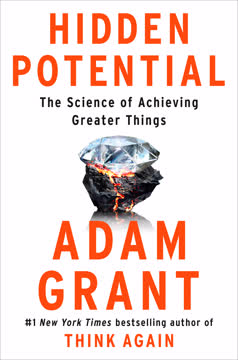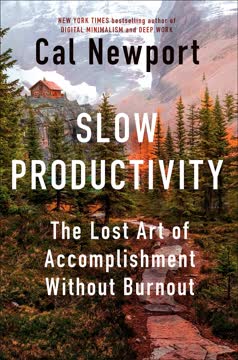Key Takeaways
1. Uptime: A New Paradigm for Productivity
Uptime is operating at a level that's sustainable.
Redefining productivity. Uptime is a holistic approach to productivity that focuses on aligning intention with action. It's not just about getting things done, but about feeling energized and productive while doing them. This concept emphasizes the importance of balancing work output with personal well-being.
Key components of Uptime:
- Clearly defining what you want to do
- Setting aside the right time and place to do it
- Executing well within the designated time
Uptime encourages individuals to understand their natural rhythms and peak times for creativity, focus, and efficiency. By recognizing these patterns, people can optimize their schedules and work environments to achieve a sustainable level of productivity that doesn't lead to burnout.
2. Define Your Top Three Priorities and Learn to Say No
Saying yes to something is always saying no to something else.
Clarity through prioritization. Identifying your top three priorities helps drive focus and ensures that you're spending time on what truly matters. This approach forces you to make conscious choices about where to allocate your time and energy, preventing you from spreading yourself too thin.
Strategies for effective prioritization:
- Regularly reassess your priorities (weekly, monthly, or quarterly)
- Align your daily tasks with these top priorities
- Learn to say no to requests that don't align with your priorities
Saying no becomes easier when you have a clear understanding of your priorities. It's not about being uncooperative, but about being intentional with your time. By framing your "no" in a positive way and offering alternatives when possible, you can maintain good relationships while protecting your time for what's most important.
3. Master the List Funnel for Effective Task Management
Lists are the heartbeat of productivity.
Structured task management. The List Funnel is a comprehensive system for organizing tasks from the macro to the micro level. It consists of four main components: the Main List, Weekly List, Daily List, and Hour-by-Hour Plan.
Components of the List Funnel:
- Main List: A brain dump of all tasks and responsibilities
- Weekly List: Tasks selected from the Main List to be completed in the current week
- Daily List: Specific tasks and priorities for the day
- Hour-by-Hour Plan: A detailed schedule of how the day will unfold
This system helps to ensure that nothing falls through the cracks while allowing for flexibility in daily execution. By regularly reviewing and updating these lists, you create a trusted system that frees up mental space and reduces stress about forgotten tasks or looming deadlines.
4. Optimize Your Schedule Based on Energy Levels
Not all time slots on your calendar are equal.
Energy-based scheduling. Understanding your personal energy patterns throughout the day is crucial for maximizing productivity. By identifying your "Power Hours" – when you feel most focused and energetic – you can schedule your most important or challenging tasks during these times.
Key concepts for energy-based scheduling:
- Power Hours: 2-3 hours of peak productivity each day
- Off-peak Hours: Times of lower energy, suitable for less demanding tasks
- Energy points: A conceptual way to think about allocating your daily energy
Aligning your tasks with your natural energy rhythms can significantly increase your overall productivity and work quality. For example, scheduling creative or strategic work during your Power Hours and administrative tasks during Off-peak Hours can lead to better outcomes and a more satisfying work experience.
5. Create a Zero-Based Calendar for Maximum Efficiency
Don't think of this as blowing up the calendar of Current You. Think of it as setting up the calendar for Future You.
Fresh start scheduling. Zero-based Calendaring involves creating your ideal schedule from scratch, rather than making minor adjustments to an existing calendar. This approach helps you prioritize what's truly important and eliminate time-wasting activities that have accumulated over time.
Steps for Zero-based Calendaring:
- Start with a blank calendar
- Add non-negotiable commitments
- Block your Power Hours and urgent time blocks
- Schedule your Off-peak Hours
- Add points of control (planning and review time)
- Include daily themes
Implementing this approach gradually allows for a smoother transition. Start by making small changes and observe how they impact your productivity and well-being. Over time, you can refine your schedule to create an optimal balance between focused work, collaboration, and personal time.
6. Manage Meetings Effectively to Boost Productivity
If an individual can attend a meeting and be on their laptop the entire time, they probably didn't need to be there.
Meeting optimization. Effective meeting management is crucial for preserving productivity. By implementing strategies to make meetings more purposeful and efficient, you can reclaim valuable time for focused work and other priorities.
Strategies for effective meetings:
- Ensure every meeting has a clear purpose, agenda, and desired outcome (PAR)
- Limit attendees to those who can add or receive value
- Keep meetings as short as possible (use the "Office Rule")
- Follow up with clear action items and decisions
Regularly review recurring meetings to ensure they're still necessary and valuable. Don't be afraid to decline meeting invitations that don't align with your priorities or where your presence isn't essential. By setting a high bar for meeting quality, you encourage others to do the same, leading to a more productive work culture.
7. Harness Technology Wisely and Practice Digital Detox
The best way to deal with a distraction is before it happens.
Intentional technology use. While technology can be a powerful productivity tool, it can also be a significant source of distraction. The key is to use technology intentionally and create boundaries to prevent it from hijacking your attention.
Strategies for managing technology:
- Customize notifications to minimize distractions
- Use keyboard shortcuts to increase efficiency
- Practice regular digital detoxes (e.g., No-Tech Tuesday)
- Create distraction-free work environments
Implementing a regular digital detox, such as No-Tech Tuesday, can help reset your relationship with technology and create space for deeper connections, creativity, and relaxation. Even small changes, like putting your phone away during meals or not checking email first thing in the morning, can have a significant impact on your focus and well-being.
8. Establish Routines and Boundaries for Work-Life Balance
Boundaries are nothing if not advertised widely.
Structured flexibility. Creating routines and setting clear boundaries helps maintain a healthy work-life balance and ensures that you're allocating time for all aspects of your life. This structure provides a framework for productivity while allowing for flexibility when needed.
Key elements of effective routines and boundaries:
- When:Then routines to establish habits
- Clearly defined and communicated work boundaries
- Regular time for personal activities and self-care
Communicate your boundaries clearly and positively to others. For example, instead of saying "I don't take meetings on Friday," say "I'm available for meetings Monday through Thursday." This positive framing helps others understand and respect your boundaries while maintaining good relationships.
9. Cultivate Mindful Mornings for a Productive Day
When you get control of your morning, you get control of your day.
Intentional mornings. How you start your day sets the tone for everything that follows. By creating a mindful morning routine, you can increase your focus, reduce stress, and improve overall productivity throughout the day.
Components of a mindful morning:
- Wake up before your first commitment
- Engage in a personal activity (e.g., meditation, reading, exercise)
- Create a pleasant environment (music, lighting, preparation)
Incorporating meditation into your morning routine can be particularly powerful. Even just 10 minutes of daily meditation can lead to increased mental clarity, reduced stress, and improved focus. By starting your day with intention and mindfulness, you set yourself up for a more productive and satisfying day ahead.
Last updated:
FAQ
What's "Uptime: A Practical Guide to Personal Productivity and Wellbeing" about?
- Focus on Productivity and Wellbeing: The book by Laura Mae Martin is a guide to enhancing personal productivity while maintaining wellbeing. It introduces the concept of "Uptime," which is about being operational and productive in all aspects of life.
- Holistic Approach: It emphasizes a holistic view of productivity, integrating work and personal life, and aligning actions with intentions to achieve balance and efficiency.
- Practical Strategies: The book provides practical strategies and tools for managing time, setting priorities, and creating effective routines to maximize productivity and personal satisfaction.
Why should I read "Uptime" by Laura Mae Martin?
- Comprehensive Framework: It offers a comprehensive framework for understanding and improving productivity, making it suitable for anyone looking to optimize their time and energy.
- Actionable Advice: The book is filled with actionable advice and real-life examples that can be easily implemented in daily life to achieve better results.
- Balance and Wellbeing: It focuses not just on getting more done but on doing it in a way that enhances overall wellbeing and life satisfaction.
What are the key takeaways of "Uptime"?
- Productivity Equals Vision Plus Execution: Productivity is about having a clear vision and executing it effectively, balancing both aspects to achieve desired outcomes.
- Importance of Downtime: Downtime is crucial for creativity and productivity, allowing the mind to rest and generate new ideas.
- Setting Boundaries: Establishing and communicating clear boundaries is essential for protecting time and energy, enabling more focused and effective work.
How does Laura Mae Martin define "Uptime"?
- Operational and Productive: Uptime is the time when you are operational and productive, whether at work or in personal life, feeling "in the zone."
- Alignment of Intention and Action: It involves aligning your intentions with your actions to ensure that you are doing the right things at the right time.
- Holistic Productivity: Uptime encompasses all aspects of life, integrating work and personal activities to create a balanced and fulfilling existence.
What is the "List Funnel" method in "Uptime"?
- Organized Task Management: The List Funnel is a system for organizing tasks from macro to micro levels, starting with a Main List and narrowing down to Daily Lists.
- Main List: This is a comprehensive list of all tasks and ideas, categorized by type of action or energy required.
- Daily and Weekly Lists: These lists break down tasks into specific actions for each day or week, ensuring that priorities are addressed and time is used effectively.
How does "Uptime" suggest dealing with procrastination?
- Identify the Why: Understanding why a task is being procrastinated on is crucial, whether it's due to it being boring, frustrating, or overwhelming.
- Swiss Cheese Method: Break down tasks into smaller, manageable parts to make starting easier and reduce the mental barrier.
- Use of Routines: Establish routines and use the when:then method to create triggers for starting tasks, making them more automatic and less daunting.
What role does downtime play in achieving "Uptime"?
- Essential for Creativity: Downtime allows the brain to rest and generate new ideas, which is essential for creativity and problem-solving.
- Balance and Recharge: It provides a necessary balance to periods of intense productivity, helping to recharge energy and prevent burnout.
- Intentional Breaks: The book emphasizes the importance of scheduling intentional breaks and downtime to enhance overall productivity and wellbeing.
How does Laura Mae Martin recommend setting priorities in "Uptime"?
- Top Three Priorities: Focus on identifying and clearly defining your top three priorities to drive focus and decision-making.
- High-Impact Tasks: Break down priorities into high-impact tasks that directly support achieving them, ensuring alignment with goals.
- Regular Reevaluation: Regularly reevaluate and adjust priorities based on changing circumstances and stages of life to maintain relevance and effectiveness.
What are some of the best quotes from "Uptime" and what do they mean?
- "Productivity = Vision + Execution": This quote emphasizes the dual nature of productivity, requiring both a clear vision and effective execution to achieve success.
- "Balance is the new busy": It challenges the traditional notion of productivity as constant busyness, advocating for a balanced approach that prioritizes wellbeing.
- "When your intention matches your action, it’s productive": This highlights the importance of aligning intentions with actions to ensure that efforts are directed towards meaningful outcomes.
How does "Uptime" address the challenges of hybrid work environments?
- Homebasers vs. Outfielders: The book identifies two types of workers in hybrid environments and provides strategies for each to optimize productivity.
- Calendar Optimization: It suggests optimizing calendars for connection and focus, scheduling tasks based on where and how you work best.
- Collaboration Tactics: Offers practical tips for effective collaboration in hybrid settings, including clear communication and setting rules of engagement.
What is the "Zero-Based Calendaring" approach in "Uptime"?
- Fresh Start Mindset: Zero-Based Calendaring involves starting with a blank calendar and building an ideal schedule from scratch, focusing on current needs.
- Building Blocks: It emphasizes identifying non-negotiable commitments, Power Hours, and points of control to create a balanced and effective schedule.
- Gradual Implementation: Encourages gradual implementation of the ideal schedule, making small changes over time to align with personal and professional goals.
How can "Uptime" help improve email management?
- Laundry Method: The book introduces the Laundry Method for email management, which involves sorting emails into categories like Respond, Read, Revisit, and Relax.
- Inbox Zero: Emphasizes achieving inbox zero by regularly sorting and addressing emails, reducing clutter and stress.
- Efficient Workflow: Provides strategies for creating an efficient email workflow, including using filters, labels, and batch processing to save time and energy.
Review Summary
Uptime receives mostly positive reviews, with readers praising its practical advice on productivity and work-life balance. Many find the book's strategies helpful for organizing tasks, managing time, and improving focus. Some reviewers note similarities to other productivity books but appreciate the modern, digital-age approach. Critics mention that some advice may not be applicable to all work situations. Overall, readers value the book's concise, actionable tips and its emphasis on wellbeing alongside productivity.
Similar Books










Download PDF
Download EPUB
.epub digital book format is ideal for reading ebooks on phones, tablets, and e-readers.




